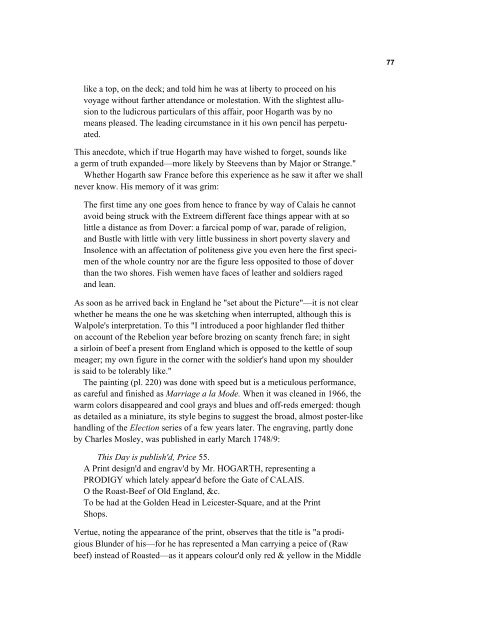Create successful ePaper yourself
Turn your PDF publications into a flip-book with our unique Google optimized e-Paper software.
like a top, on the deck; <strong>and</strong> told him he was at liberty to proceed on his<br />
voyage without farther attendance or molestation. With the slightest allu-<br />
sion to the ludicrous particulars of this affair, poor <strong>Hogarth</strong> was by no<br />
means pleased. The leading circumstance in it his own pencil has perpetu-<br />
ated.<br />
This anecdote, which if true <strong>Hogarth</strong> may have wished to forget, sounds like<br />
a germ of truth exp<strong>and</strong>ed—more likely by Steevens than by Major or Strange."<br />
Whether <strong>Hogarth</strong> saw France before this experience as he saw it after we shall<br />
never know. <strong>His</strong> memory of it was grim:<br />
The first time any one goes from hence to france by way of Calais he cannot<br />
avoid being struck with the Extreem different face things appear with at so<br />
little a distance as from Dover: a farcical pomp of war, parade of religion,<br />
<strong>and</strong> Bustle with little with very little bussiness in short poverty slavery <strong>and</strong><br />
Insolence with an affectation of politeness give you even here the first speci-<br />
men of the whole country nor are the figure less opposited to those of dover<br />
than the two shores. Fish wemen have faces of leather <strong>and</strong> soldiers raged<br />
<strong>and</strong> lean.<br />
As soon as he arrived back in Engl<strong>and</strong> he "set about the Picture"—it is not clear<br />
whether he means the one he was sketching when interrupted, although this is<br />
Walpole's interpretation. To this "I introduced a poor highl<strong>and</strong>er fled thither<br />
on account of the Rebelion year before brozing on scanty french fare; in sight<br />
a sirloin of beef a present from Engl<strong>and</strong> which is opposed to the kettle of soup<br />
meager; my own figure in the corner with the soldier's h<strong>and</strong> upon my shoulder<br />
is said to be tolerably like."<br />
The painting (pl. 220) was done with speed but is a meticulous performance,<br />
as careful <strong>and</strong> finished as Marriage a la Mode. When it was cleaned in 1966, the<br />
warm colors disappeared <strong>and</strong> cool grays <strong>and</strong> blues <strong>and</strong> off-reds emerged: though<br />
as detailed as a miniature, its style begins to suggest the broad, almost poster-like<br />
h<strong>and</strong>ling of the Election series of a few years later. The engraving, partly done<br />
by Charles Mosley, was published in early March 1748/9:<br />
This Day is publish'd, Price 55.<br />
A Print design'd <strong>and</strong> engrav'd by Mr. HOGARTH, representing a<br />
PRODIGY which lately appear'd before the Gate of CALAIS.<br />
O the Roast-Beef of Old Engl<strong>and</strong>, &c.<br />
To be had at the Golden Head in Leicester-Square, <strong>and</strong> at the Print<br />
Shops.<br />
Vertue, noting the appearance of the print, observes that the title is "a prodi-<br />
gious Blunder of his—for he has represented a Man carrying a peice of (Raw<br />
beef) instead of Roasted—as it appears colour'd only red & yellow in the Middle<br />
77
















